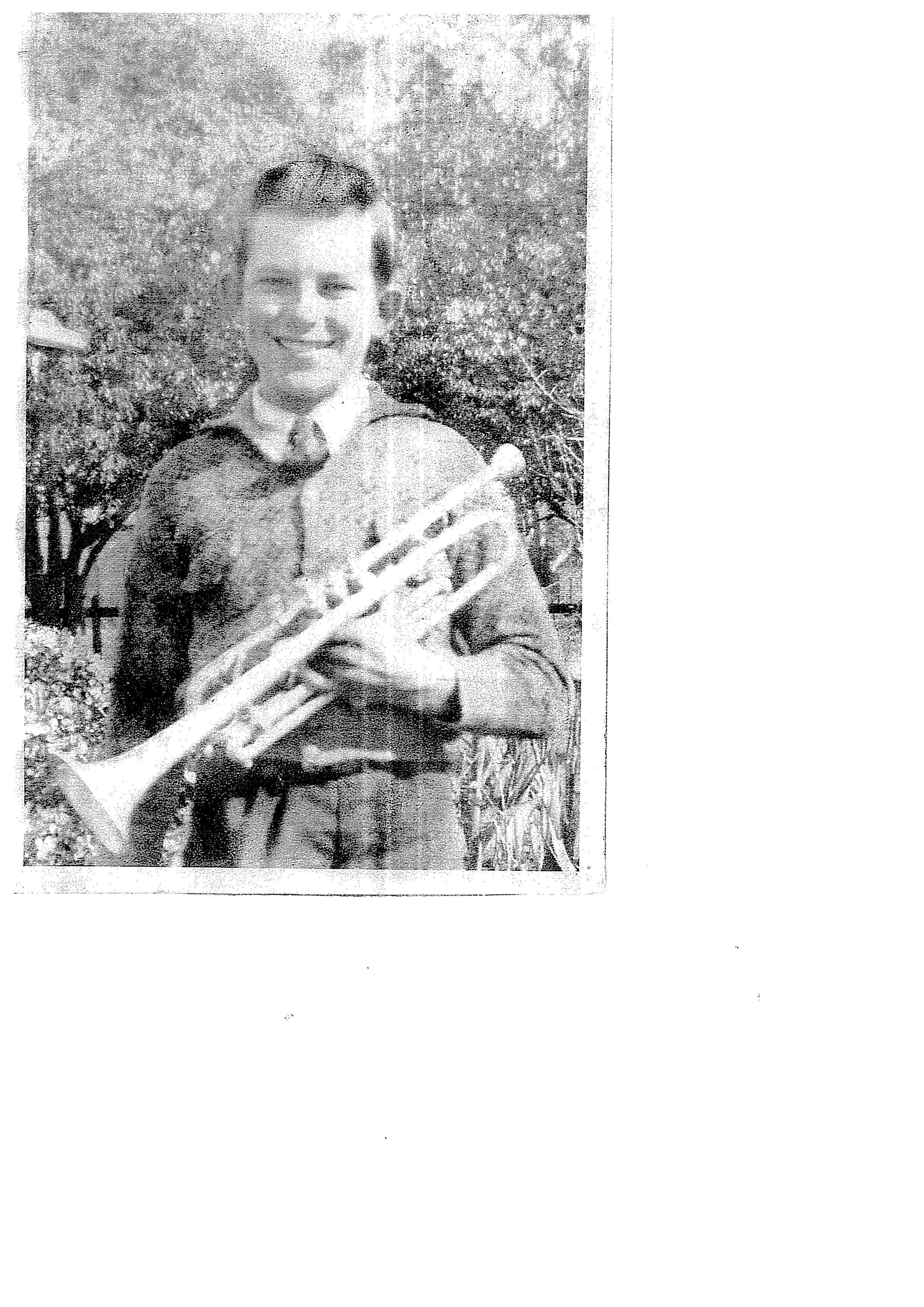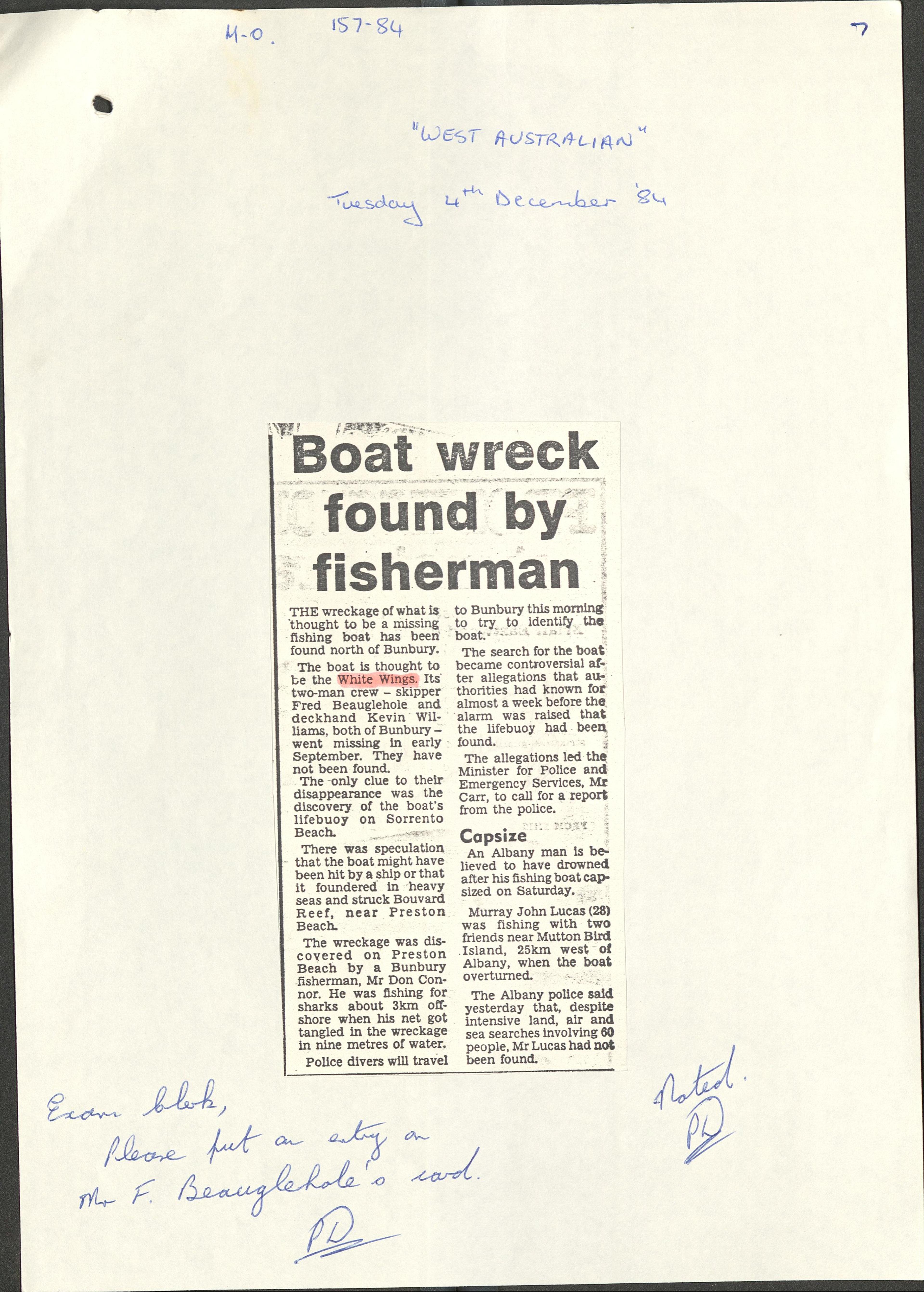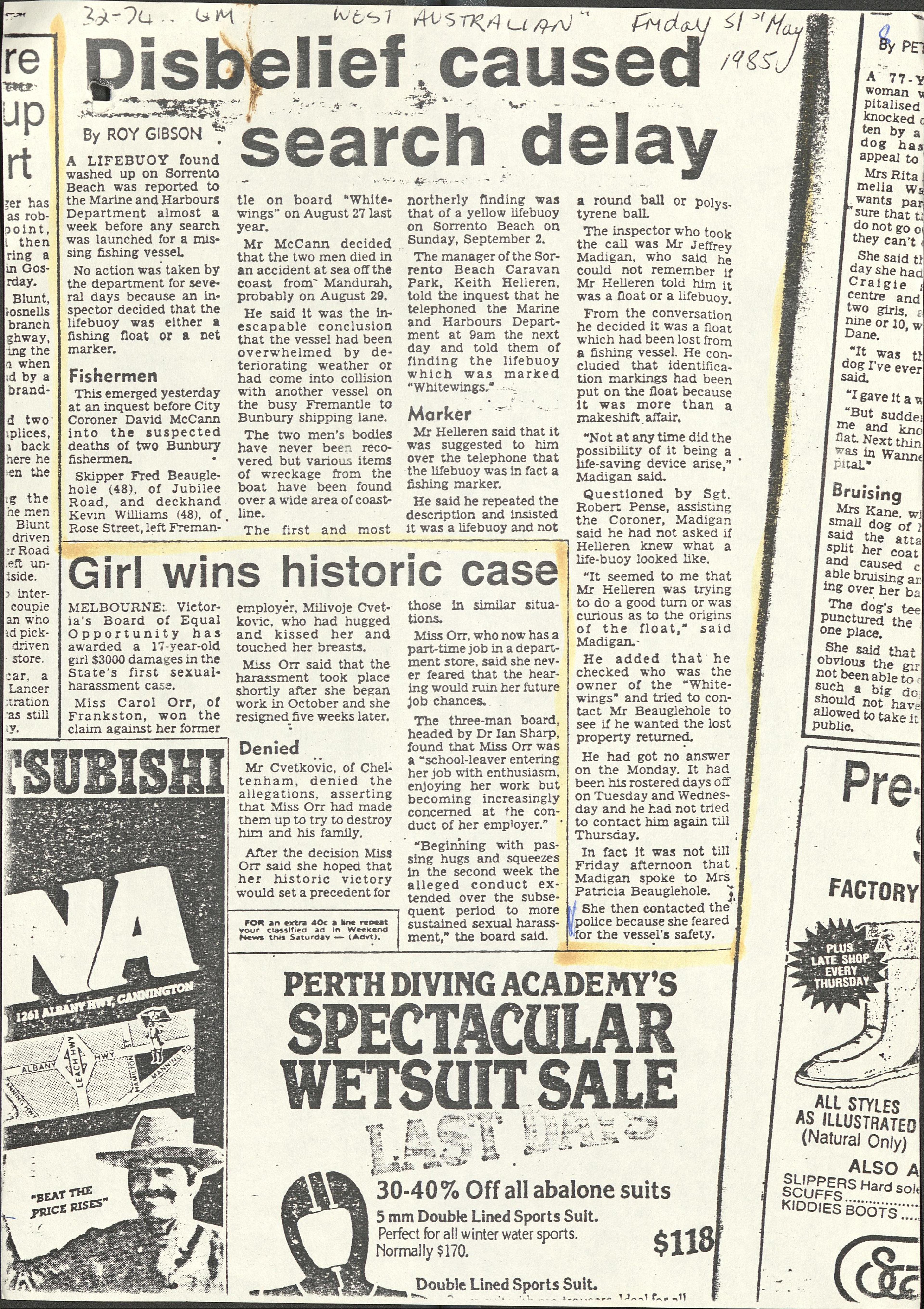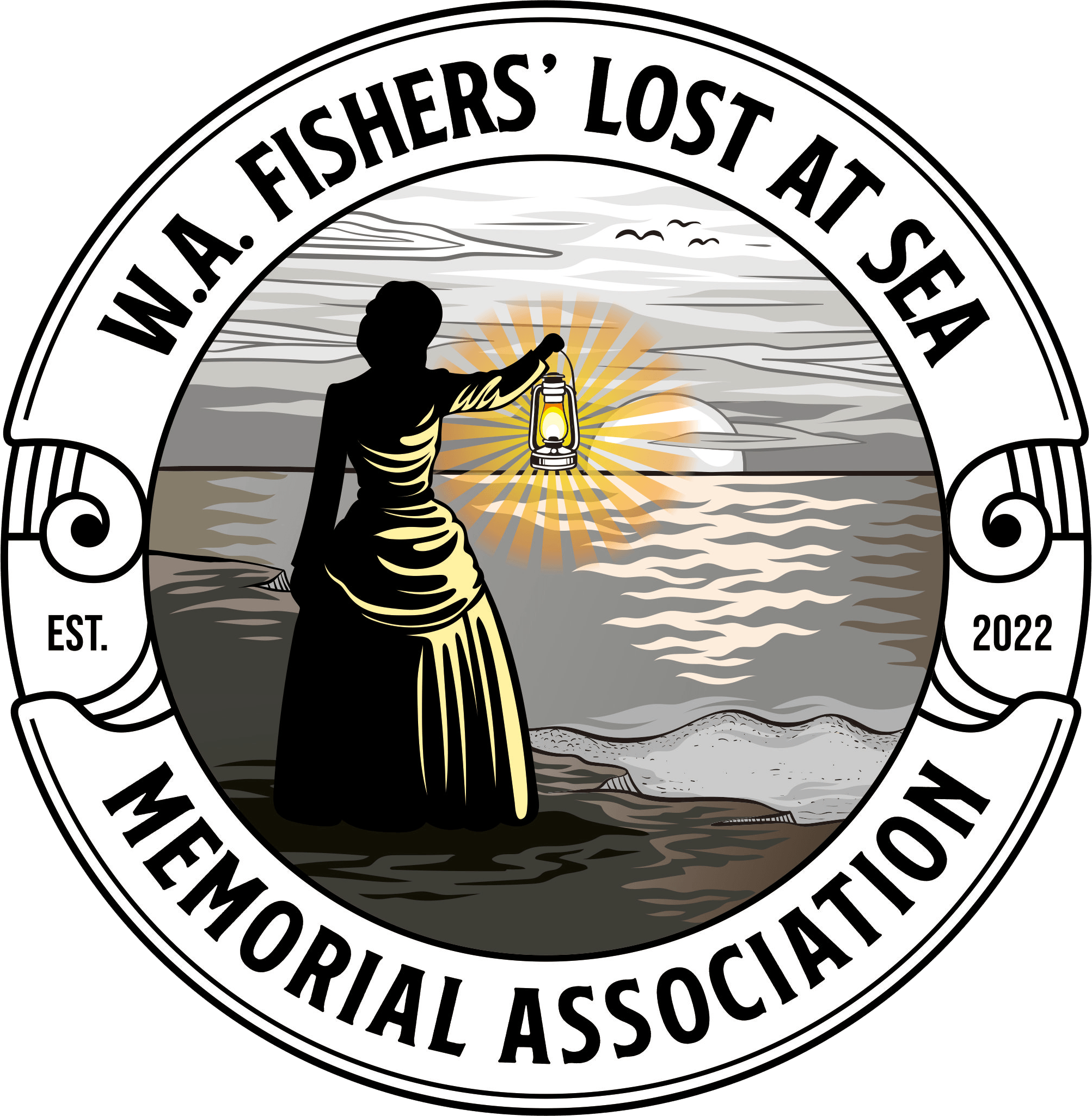White Wings
Vessel Name: White Wings
Frederick Benjamin Beauglehole
Kevin Edward Williams
Drowned at sea; Never found
29 August 1984

A young Fred Beauglehole

Local newspapers covered the tragedy and location of the wreck

Newspapers questioned the delay to the search
At about 1pm on Monday, 27 August 1984, the licensed fishing boat M17, White Wings, departed from the Fremantle Fishing Boat Harbour. Onboard were:
- Frederick (Fred) Benjamin Beauglehole, 48 years old, born 19 June 1936 in Bunbury, WA
- Kevin Edward Williams, 48 years old, born in 1936 in Kalgoorlie, WA
Fred Beauglehole was the owner/skipper of the vessel, and Kevin Williams was the deckhand on the vessel. Fred Beauglehole was known as an experienced and competent skipper, and the vessel White Wings was well founded.
It was the intention that the vessel would travel to an area known as Mount Williams, or William Shoal, about five miles south of Mandurah and about fifteen miles offshore, and to fish in the area until the freezer onboard was full and then to travel to Bunbury. It was anticipated that the vessel would arrive at Bunbury Harbour on, or about, 10 September.
Fred had made arrangements with another professional fisherman to maintain regular radio contact during the trip. Contact was made at 1pm on Tuesday, 28 August 1984, when Fred stated the position of the White Wings to be 32° 35″ South, 115° 20″ East, that is the area of William Shoal.
At 10am on Wednesday, 29 August an attempt was made to contact the White Wings by radio, but without success.
The weather and sea conditions deteriorated in the area between Mandurah and Bunbury, with strong westerly and south-westerly winds up to 45 knots.
On Sunday, 2 September, a yellow life buoy marked ‘White Wings’ was found washed up on the beach in front of the Sorrento Beach Caravan Park. The next day the Manager of the caravan park, Keith Helleron, telephoned the Marine and Harbours Department at 9am and told them of finding a float, or buoy, which was marked M17 ‘White Wings’.
From a report given by Marine Inspector, G. Madigan on 14 September, there was some confusion as to exactly what Keith Helleron had found, and from the description given, Madigan considered it to be a buoy used to anchor and/or mark the position of long lines or nets, and that it had been lost. There had been no reports of a boat overdue, missing or lost to alert him to the fact that the find could be of more significance.
The Survey Clerk was telephoned and the owner of the MFL number was contacted by Madigan, however it was not until Friday, 7 September at 3.15 pm that Patricia Beauglehole answered.
She was concerned as her husband had been away for over two weeks and after speaking with her daughter-in-law the next day, Madigan advised them to contact the Bunbury Police, which they did and an alert was put out for the missing boat.
The West Australian reported on Tuesday, 4 September of a Bunbury fisherman, Don Connor, whose net got tangled up with wreckage three kilometres offshore and in nine metres of water. He was fishing for sharks at the time, police divers were sent to Bunbury to try and identify the boat thought to be that of White Wings.
By 7 September, the White Wings had not arrived at Bunbury Harbour and an alert was raised followed by air and sea searches. The air search area extended from Sorrento to Augusta.
On Sunday 9 September, a metal beacon was found on the beach at Binningup. This was later identified as coming from the White Wings, and a number of other items, identified as coming from the vessel, were located in the sea and along the shore between Preston Beach and the Stragglers.
The bodies of the lost men were never found.
An inquiry into the circumstances of the suspected deaths of Frederick Beauglehole and Kevin Williams, as determined at Perth on 30 May 1985 by David A McCann (City Coroner), stated the cause of death as ‘died at sea when the vessel White Wings was either overwhelmed by deteriorating sea conditions, or came into collision with a large vessel’.
The Coroner recommended that all life saving appliances be marked with the name, or number of the vessel on which they are carried.
The Chief Marine Surveyor, A. McAllister, instructed all surveyors, by letter dated 16 August 1985, that ‘at the next survey of all vessels the following equipment is to be marked:
- Life Jackets
- Life Rafts (Rigid)
- Lifeboats
- Lifebuoys
As all inflatable life rafts carry a serial number, the parent vessel can be identified from that number’.
Surveyors had been insisting that the above items be marked with the vessel’s fishing number, or name, for many years, it had now become a requirement as part of a vessel survey.
The search for the boat became controversial, after allegations that authorities knew about the finding of the lifebuoy two weeks before the alarm was raised. The allegations led the Minister for Police and Emergency Services, Mr Carr, to call for a report from the Police.
The outcome led to all officers of the Marine and Harbours Department being instructed to question any person finding an article, as to whether that person believes the safety of a vessel is involved. They were also instructed that when an article bears an identifying number, or name, it should be assumed that the article belongs to the safety gear of a vessel, and it should be presumed that the safety of a person or vessel is in question. The article should be promptly recovered and examined by a competent person so that a proper assessment of the situation can be made.
The above was a step forward in the safety practices of the fishing industry of the day.
Fred Beauglehole is remembered at Bunbury Cemetery with a plaque on the grave of his brother, Kim, who died at the young age of 12, on 1 November 1959, and his brother Doug, who died at the age of 30, on 22 March 1970. Both were married with families.
